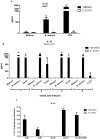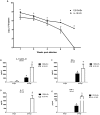Lack of endogenous IL-10 enhances production of proinflammatory cytokines and leads to Brucella abortus clearance in mice
- PMID: 24069337
- PMCID: PMC3775771
- DOI: 10.1371/journal.pone.0074729
Lack of endogenous IL-10 enhances production of proinflammatory cytokines and leads to Brucella abortus clearance in mice
Abstract
IL-10 is a cytokine that regulates the balance between pathogen clearance and immunopathology. Brucella abortus is an intracellular bacterium that causes chronic disease in humans and domestic animals. Here we evaluated the contribution of IL-10 in host immune response and pathology during B. abortus infection. To assess the role of IL-10 in vivo, IL-10 knockout (KO) or 129 Sv/Ev (wild-type) mice were infected with B. abortus and the number of viable bacteria from the spleen was determined at 1, 2, 3, 6 and 14-weeks postinfection. IL-10 KO mice showed reduced bacterial loads in the spleen when compared to wild-type mice during all time points studied. Additionally, at 14-weeks postinfection IL-10 KO mice had totally cleared the infection. This clearance was preceded by an enhanced IFN-γ, TNF-α and IL-17 responses in both the serum and the spleen of IL-10 KO mice. Additionally, dendritic cells from infected IL-10 KO mice produced elevated levels of IL-12 and TNF-α compared to wild-type animals. Histopathology analysis was performed and both KO and wild-type mice developed multifocal granulomas and necrosis in the liver. However, at six-weeks postinfection reduced numbers of granulomas was detected in IL-10 KO mice compared to wild-type animals. This reduced liver pathology at later stage of infection was accompanied by increased numbers of CD4+CD25+foxp3+ T cells and expression of TGF-β in IL-10 KO splenocytes. Taken together, our findings demonstrate that IL-10 modulates the proinflammatory immune response to B. abortus infection and the lack of IL-10 increases resistance to Brucella infection.
Conflict of interest statement
Figures






References
-
- Movat HZ, Cybulsky MI, Colditz IG, Chan MK, Dinarello CA (1987) Acute inflammation in gram-negative infection: endotoxin, interleukin 1, tumor necrosis factor, and neutrophils. Fed Proc 46: 97–104. - PubMed
-
- Couper KN, Blount DG, Riley EM (2008) IL-10: the master regulator of immunity to infection. J Immunol 180: 5771–5777. - PubMed
-
- Gazzinelli RT, Wysocka M, Hieny S, Scharton-Kersten T, Cheever A, et al. (1996) In the absence of endogenous IL-10, mice acutely infected with Toxoplasma gondii succumb to a lethal immune response dependent on CD4+ T cells and accompanied by overproduction of IL-12, IFN-gamma and TNF-alpha. J Immunol 157: 798–805. - PubMed
-
- Hunter CA, Ellis-Neyes LA, Slifer T, Kanaly S, Grunig G, et al. (1997) IL-10 is required to prevent immune hyperactivity during infection with Trypanosoma cruzi. J Immunol 158: 3311–3316. - PubMed
Publication types
MeSH terms
Substances
LinkOut - more resources
Full Text Sources
Other Literature Sources
Molecular Biology Databases
Research Materials

